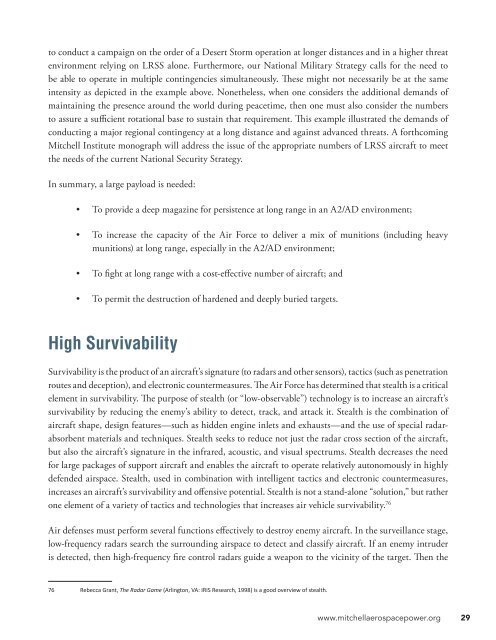You also want an ePaper? Increase the reach of your titles
YUMPU automatically turns print PDFs into web optimized ePapers that Google loves.
to conduct a campaign on the order of a Desert Storm operation at longer distances and in a higher threat<br />
environment relying on LRSS alone. Furthermore, our National Military Strategy calls for the need to<br />
be able to operate in multiple contingencies simultaneously. These might not necessarily be at the same<br />
intensity as depicted in the example above. Nonetheless, when one considers the additional demands of<br />
maintaining the presence around the world during peacetime, then one must also consider the numbers<br />
to assure a sufficient rotational base to sustain that requirement. This example illustrated the demands of<br />
conducting a major regional contingency at a long distance and against advanced threats. A forthcoming<br />
Mitchell Institute monograph will address the issue of the appropriate numbers of LRSS aircraft to meet<br />
the needs of the current National Security Strategy.<br />
In summary, a large payload is needed:<br />
• To provide a deep magazine for persistence at long range in an A2/AD environment;<br />
• To increase the capacity of the Air Force to deliver a mix of munitions (including heavy<br />
munitions) at long range, especially in the A2/AD environment;<br />
• To fight at long range with a cost-effective number of aircraft; and<br />
• To permit the destruction of hardened and deeply buried targets.<br />
High Survivability<br />
Survivability is the product of an aircraft’s signature (to radars and other sensors), tactics (such as penetration<br />
routes and deception), and electronic countermeasures. The Air Force has determined that stealth is a critical<br />
element in survivability. The purpose of stealth (or “low-observable”) technology is to increase an aircraft’s<br />
survivability by reducing the enemy’s ability to detect, track, and attack it. Stealth is the combination of<br />
aircraft shape, design features—such as hidden engine inlets and exhausts—and the use of special radarabsorbent<br />
materials and techniques. Stealth seeks to reduce not just the radar cross section of the aircraft,<br />
but also the aircraft’s signature in the infrared, acoustic, and visual spectrums. Stealth decreases the need<br />
for large packages of support aircraft and enables the aircraft to operate relatively autonomously in highly<br />
defended airspace. Stealth, used in combination with intelligent tactics and electronic countermeasures,<br />
increases an aircraft’s survivability and offensive potential. Stealth is not a stand-alone “solution,” but rather<br />
one element of a variety of tactics and technologies that increases air vehicle survivability. 76<br />
Air defenses must perform several functions effectively to destroy enemy aircraft. In the surveillance stage,<br />
low-frequency radars search the surrounding airspace to detect and classify aircraft. If an enemy intruder<br />
is detected, then high-frequency fire control radars guide a weapon to the vicinity of the target. Then the<br />
76 Rebecca Grant, The Radar Game (Arlington, VA: IRIS Research, 1998) is a good overview of stealth.<br />
www.mitchellaerospacepower.org 29


